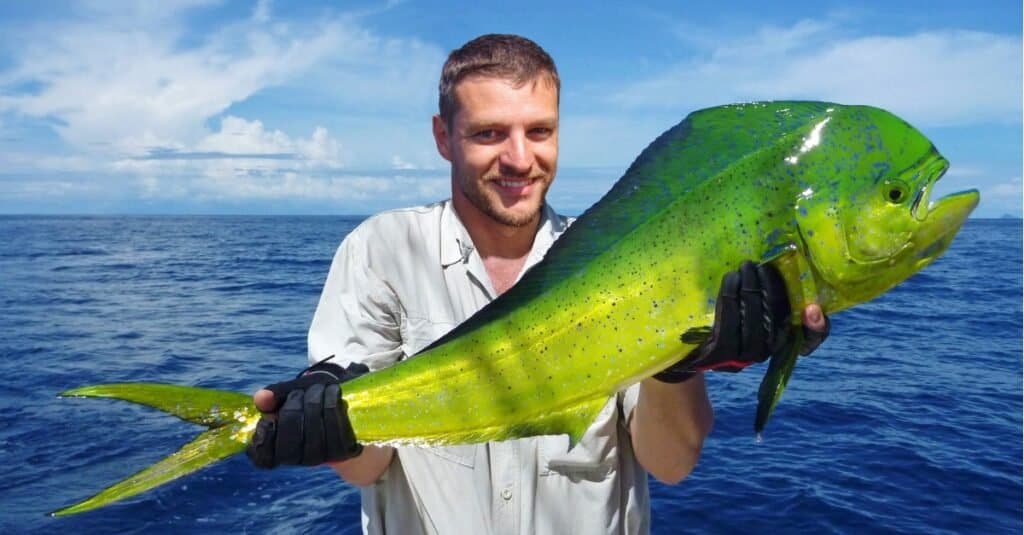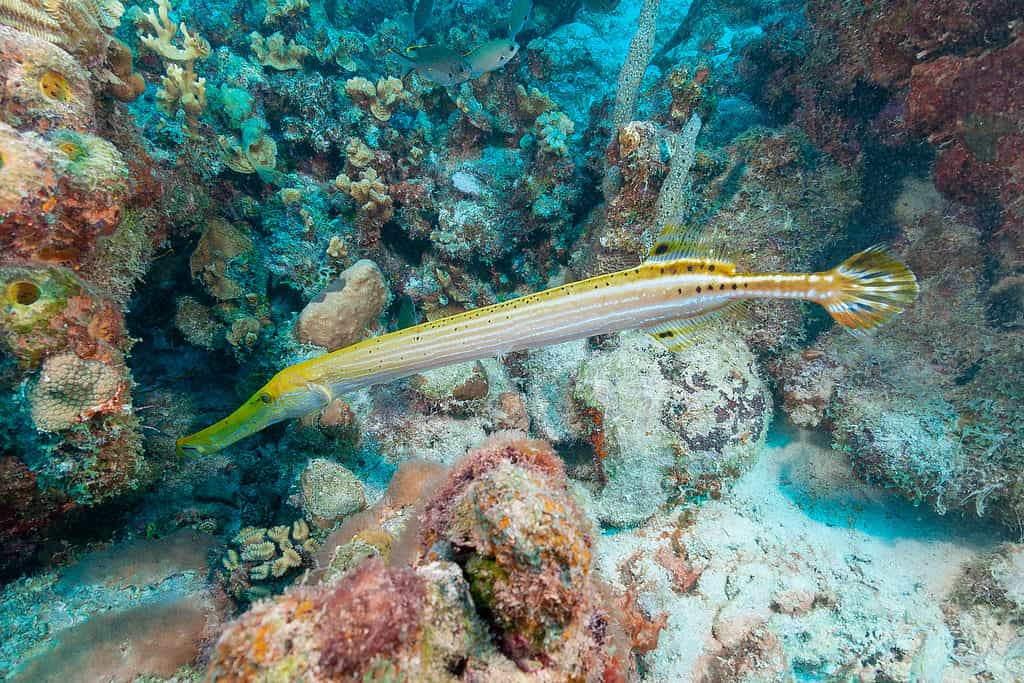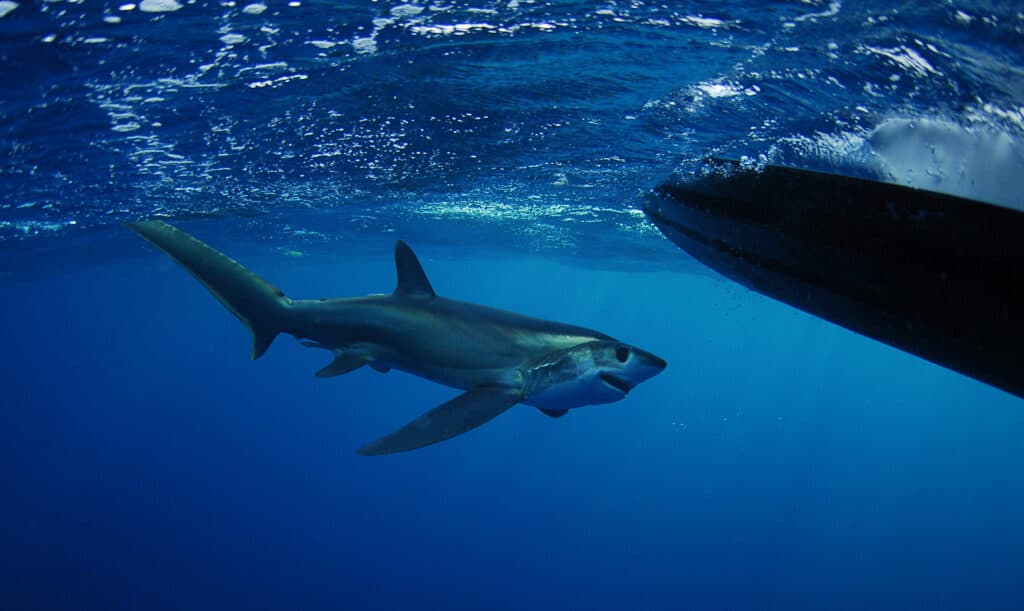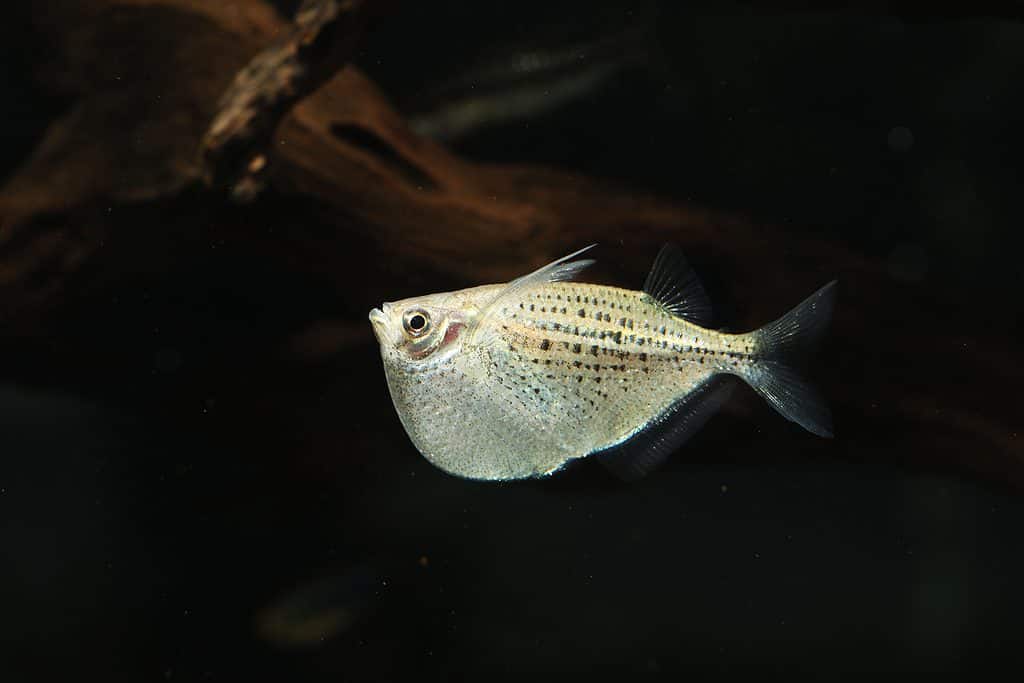Panama is a Central American country located between Costa Rica and Columbia. Perhaps its most famous feature, the Panama Canal, is a manmade waterway that links the Atlantic and Pacific Oceans. The country lies between both bodies of water, giving it access to a vastly diverse area of aquatic species. Read on to discover eight spectacular fish found in Panama!
1. Common Dolphinfish

The dolphinfish is most famous for its striking coloration.
©iStock.com/Sablin
One of the most spectacular fish found in Panama is the common dolphinfish (Coryphaena hippurus), also known as the mahi-mahi or dorado. This giant fish is distinctive in part for its bulging forehead crest in males and its single dorsal fin extending the length of its body. However, it is most famous for its striking coloration: metallic bluish-green backs, silvery sides with a golden sheen, and rows of lateral dark or golden spots. When this fish leaves the water or dies, its colors may rapidly change and then fade to a greyish hue.
The common dolphinfish grows up to 6.89 feet in length with a maximum weight of 88 pounds. It can survive in marine and brackish waters, swimming at depths above 280 feet.
2. Cubera Snapper

The cubera snapper is renowned for its impressive size and intimidating teeth.
©Lynn Archer/Shutterstock.com
The cubera snapper or Cuban snapper (Lutjanus cyanopterus) is a popular commercial and sport fish in Panama renowned for its impressive size and intimidating teeth. This reef-associated fish swims in marine or brackish waters at depths between 59-230 feet. Its thick lips are one of its most distinctive features. It also sports sharp canine teeth with one enlarged pair that protrudes even when its mouth is closed.
The cubera snapper grows to a maximum length of 5.25 feet and a maximum weight of 125 pounds. These fish are typically brown to grey in color, though some individuals may display a reddish tint.
3. Common Sawfish

The common sawfish species is sharklike in appearance.
©Forrest Samuels / CC BY-SA 2.0 – License
The common sawfish (Pristis pristis) is one of the oddest-looking fish found in Panama. Its name derives from its saw-like rostrum or snout, equipped with up to 20 pairs of spines or “teeth.” It uses this rostral blade to injure or kill prey, which includes other fishes and bottom-dwelling animals. This species is sharklike in appearance, though it belongs to the order Rhinopristiformes (shovelnose rays).
The common sawfish is a massive fish, growing to lengths of up to 24.6 feet. It can survive in marine, brackish, and freshwater environments.
4. Trumpetfish

Trumpetfish often swim upside-down to blend in with vertical coral.
©Jesus Cobaleda/Shutterstock.com
The trumpetfish (Aulostomus maculatus) is a unique fish inhabiting the Atlantic waters off Panama. This reef-associated species swims at depths between 6.5-82 feet, lurking among coral or behind larger herbivorous fish to ambush its prey. It often swims upside-down to blend in with vertical coral or other environmental features.
The trumpetfish grows up to 3.28 feet in length. Its elongated, compressed body ends in a long, tubular snout that opens as wide as its body to draw in prey.
5. Atlantic Thresher Shark

Despite its intimidating appearance, the Atlantic thresher shark is harmless to humans.
©FtLaud/Shutterstock.com
One of the larger fish found in Panama is the Atlantic thresher shark (Alopias vulpinus), one of many shark species that swim off the country’s coasts. Despite its intimidating appearance, experts consider this species harmless to humans. Its most distinctive feature is the pointed upper lobe of its caudal fin, which is often longer than the rest of the shark. By contrast, the lower lobe is short.
The Atlantic thresher shark grows to a maximum length of 20 feet and weighs up to 767 pounds. Its dorsal region is blackish, brown, grey, or bluish-grey with lighter sides and a white underbelly.
6. Spotted Hatchetfish

Despite its prominent belly, the spotted hatchetfish is a small fish.
©Pavaphon Supanantananont/Shutterstock.com
The spotted hatchetfish (Gasteropelecus maculatus) gets its name from its deep-keeled, hatchet-shaped belly. Gasteropelecus derives from the Greek words for “stomach” and “hatchet.” This unique fish inhabits freshwater bodies in eastern Panama. Its winglike pectoral fins enable it to glide through the air for short stretches after it leaps from the water.
Despite its prominent belly, the spotted hatchetfish is a small fish, growing to a maximum length of 2.5 inches. Because of its size, its diet consists mainly of small crustaceans, mosquitoes, and larvae.
7. Swordsnout Grenadier
The swordsnout grenadier (Coelorinchus occa) is a bizarre deep-water fish in Panama. Its name derives from its long, pointed snout resembling a sword. Its head is ridged and spined, tapering through the body to a narrow, trailing tail. The dorsal region of its body is brownish in color while the underside is darker.
The swordsnout grenadier is thought to grow to a maximum length of 1.64 feet, though it may possibly exceed this size. It dwells at depths between 1,312-7,284 feet.
8. Coral Hawkfish

Another name for the coral hawkfish is the sharp-headed hawkfish.
©thomas eder/Shutterstock.com
The coral hawkfish (Cirrhitichthys oxycephalus), also known as the pixy hawkfish, is a brightly-colored marine fish in Panama. This reef-associated species swims at depths of up to 130 feet, preferring areas with clear water and rich coral growth. Its base color ranges from whitish to pink with grey, black, or bright red blotches. Another name for this fish, sharp-headed hawkfish, references its pointed snout.
The coral hawkfish grows to a maximum length of 3.93 inches. It preys on crustaceans and small fishes.
Up Next:
- Discover 7 Spectacular Fish Found in Cuba
- Discover 9 Spectacular Fish Found in Turkey
- Discover 7 Spectacular Fish Found in the Bahamas
The photo featured at the top of this post is © iStock.com/DonFink
Thank you for reading! Have some feedback for us? Contact the AZ Animals editorial team.






